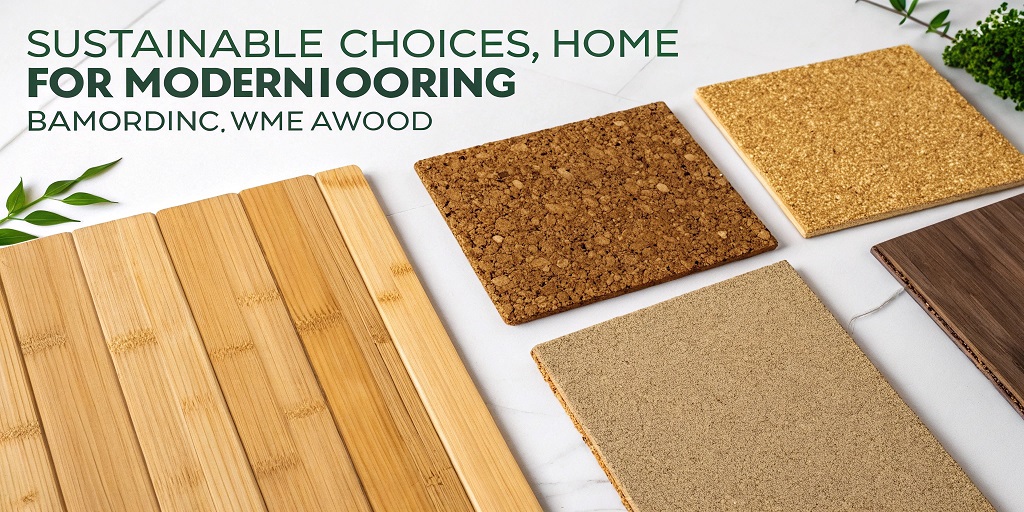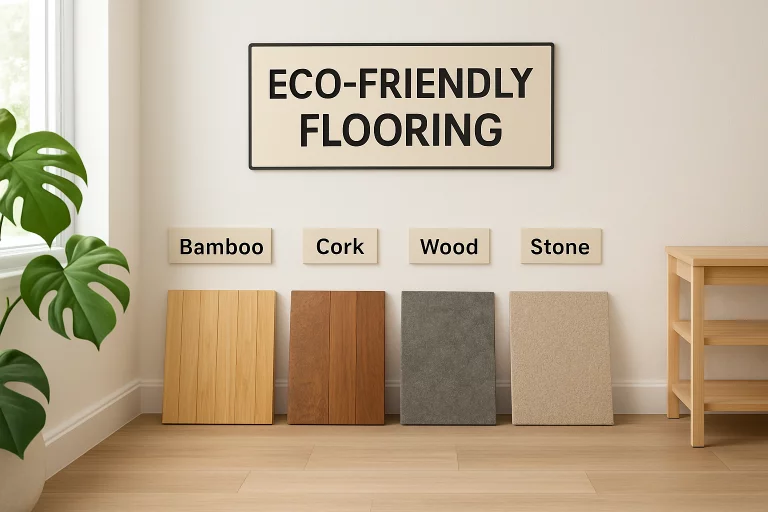
Sustainable Choices for Modern Home Flooring
Key Takeaways
- Sustainable flooring options balance eco-friendliness, durability, and beauty, enabling you to prioritize both design and the environment.
- Certification from reputable organizations like the Forest Stewardship Council ensures products are responsibly sourced.
- Choosing locally sourced or repurposed materials—such as reclaimed wood and regional stone—significantly reduces environmental impact.
- Committing to green flooring solutions, from bamboo to concrete, helps protect the planet while supporting healthier, more comfortable homes.
Sustainable flooring options revitalize your home’s look and encourage mindful consumption and responsible design. Today’s vast array of environmentally friendly materials—from renewable bamboo and cork to repurposed wood and polished concrete—makes it easier to align your living environment with your core values. With every green choice, you help lay the foundation for a healthier home and a more sustainable future.
Table of Contents
- Introduction
- Bamboo Flooring
- Cork Flooring
- Reclaimed Wood
- Linoleum
- Recycled Glass Tiles
- Natural Stone
- Wool Carpets
- Concrete
Introduction
Choosing the right flooring for your home is a pivotal decision that extends well beyond personal aesthetics—it’s an investment in your well-being and a conscious step toward environmental responsibility. With the collective shift towards sustainability, homeowners today seek ways to minimize their carbon footprint while crafting beautiful and functional interiors. As eco-conscious values gain momentum, an ever-growing range of flooring solutions embodies the perfect balance of style, comfort, durability, and positive environmental impact. Making informed, sustainable choices can significantly reduce your household’s ecological footprint, and it all starts with understanding your options. To learn more about sustainable flooring and expert craftsmanship, you can visit SOEN for in-depth resources and recommendations.
This guide provides a comprehensive guide on selecting green flooring materials for home renovations. It discusses the benefits, environmental advantages, and considerations when choosing eco-friendly options. By choosing eco-friendly materials, you can create environmentally friendly interiors that benefit your lifestyle and design preferences. This approach promotes a healthier home and supports global sustainability efforts.
Bamboo Flooring
Bamboo is gaining popularity as a sustainable flooring option due to its quick harvest readiness and quick regenerative nature. Manufacturers process bamboo into high-strength planks that rival or even surpass traditional hardwoods in resilience. Choose responsibly harvested products with low VOC emissions to maximize eco-friendly benefits, reducing chemicals off-gassing into living spaces. Bamboo’s innate resistance to insects, mold, and moisture enhances its durability and creates a healthier home environment. Its wide range of finishes, colors, and grain patterns makes it a versatile option. For more information on responsibly sourced bamboo and green building materials, consult resources like the U.S. Green Building Council.

Cork Flooring
Cork flooring is renowned for its truly renewable production process. Sourced by harvesting the outer bark of cork oak trees, it does not harm the tree itself. These remarkable trees can live for centuries, and their bark regenerates every nine years, resulting in a long-term, sustainable yield. Cork’s unique composition gives it a satisfyingly soft, slightly springy feel underfoot, making it exceptionally comfortable for rooms where you may stand for extended periods, such as kitchens or home offices.
Beyond its comfort, cork offers exceptional heat and sound insulation, acting as a buffer that enhances energy efficiency and reduces noise transmission between rooms. Its naturally antimicrobial properties are invaluable for households concerned about allergens or respiratory sensitivities. To guarantee your cork flooring aligns with the highest sustainability standards, opt for products certified by reputable organizations like the Forest Stewardship Council (FSC), which certifies that materials are sourced from responsibly managed forests. Learn more about FSC certification by visiting the Forest Stewardship Council.
Reclaimed Wood
Reclaimed wood offers an incredibly sustainable and visually captivating flooring solution. This flooring drastically reduces the demand for fresh-cut lumber and helps conserve forests by repurposing timber from old barns, industrial buildings, and other structures. Each piece of reclaimed wood tells a story, adorned with the time-earned knots, grain marks, and weathered patinas that add charm and authenticity to any modern or rustic interior.
Aside from its striking appearance, reclaimed wood often comes from old-growth trees, giving it greater density, strength, and longevity than many newly harvested hardwoods. Since the timber has already aged and acclimated, it’s less prone to warping or shrinking, ensuring lasting beauty for generations. Choosing reclaimed wood is not just a celebration of craftsmanship and history—it’s a conscious step toward circular design and waste reduction.
Linoleum
Linoleum is an exemplary choice for sustainable flooring, particularly when differentiated from its synthetic cousin, vinyl. Linoleum is biodegradable and low-impact, crafted entirely from natural and renewable resources—namely linseed oil, wood flour, cork dust, and natural pigments. This classic material has graced homes for over a century, earning a reputation for longevity, often lasting four decades or more with routine care.
Available in a rainbow of colors and various patterns, linoleum seamlessly adapts to contemporary, artistic, or even retro home designs. Its antibacterial properties, moisture resistance, and ease of cleaning make it practical for frequently used spaces, such as kitchens, mudrooms, and children’s play areas. Confirm that your linoleum purchase contains minimal artificial additives or synthetic backing materials for maximum environmental benefit.
Recycled Glass Tiles
Recycled glass tiles bring a distinct luminosity and artistry to sustainable interior design. Crafted from post-consumer glass bottles and industrial glass waste, these tiles offer a stunning second life for materials that might otherwise occupy landfills for centuries. Their reflective qualities can brighten dark spaces, adding visual intrigue and a unique sense of character to backsplashes, bathrooms, accent walls, or even residential floors.
Aside from their captivating beauty, recycled glass tiles are efficient. They are non-porous, naturally impervious to water, mildew, and stains, and incredibly simple to clean. Their durability and boundless color palette empower homeowners to create elegant, eco-friendly spaces. By supporting recycled content, you directly help to close the loop in material cycles and support a circular economy.
Natural Stone
Natural stone flooring—marble, granite, slate, and limestone—provides unparalleled sophistication and exceptional longevity. Because these stones are extracted with relatively minimal processing, their environmental footprint is lower than synthetic materials, mainly locally sourced. Natural stone’s enduring beauty and resilience mean your flooring will rarely, if ever, require replacement, making this a thoughtful long-term investment.
Focus on stones quarried locally in your region for the most sustainable choice. This reduces emissions resulting from transportation and often guarantees more ethical labor practices. Given the immense variety of textures, finishes, and colorations, natural stone can elevate both traditional and contemporary interiors while supporting a commitment to environmental stewardship.
Wool Carpets
Wool is celebrated as one of the most eco-friendly soft flooring options available. Sheared from sheep, whose fleece naturally regenerates yearly, wool is a fully renewable and biodegradable resource. Its fibers moderate indoor humidity and filter airborne particles, enhancing respiratory health and indoor air quality for everyone in your home. Wool carpet’s exceptional texture and plushness create a cozy, inviting atmosphere underfoot. They are inherently stain-resistant, flame-retardant, and durable, meaning they will hold up under the demands of busy family life. With proper care, wool carpets will last for many years, breaking down naturally at the end of their lifespan instead of lingering in landfills. Wool carpeting is an unbeatable, environmentally friendly choice from ethically treated sheep and responsible producers.
Concrete
Polished concrete floors are revolutionizing green home design for their raw beauty, remarkable strength, and lower environmental impact. If your home already features a concrete subfloor, polishing and sealing this existing surface saves materials, adds longevity, and eliminates the environmental burden of additional flooring layers. New concrete floors can be greener using recycled aggregates and non-toxic finishing agents.
Concrete’s vast thermal mass stabilizes indoor temperatures by slowly absorbing and releasing heat, which can significantly lower your household’s heating and cooling costs. Regular sealing with water-based or non-toxic compounds minimizes maintenance while supporting indoor air quality. The seamless, contemporary look of polished concrete fits both industrial and modern design sensibilities, making it an ideal foundation for stylish, healthy, and energy-efficient living spaces.


Average Rating